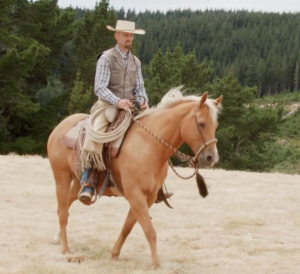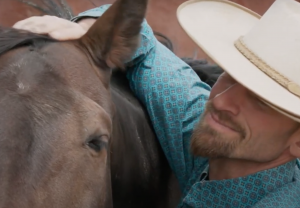In this episode, we respond to a listener question about bitless options. Ellie writes from Zimbabwe. Pretty nifty, huh? She says: my question is about ‘bitless’ bridles, side pulls, or the bosals or any other type of ‘bitless’ bridle that you may have had experience with. Which would be most suitable for what horse, temperament, type of exercise or work. I am in the process of starting a horse. We are in first rides with rope halter and rather than bit him for our first rides, I thought maybe I could just train him to a more subtle bridle.
 So, one of the people I thought of when I read this question was Ben Longwell who runs True West Horsemanship with his wife, Natalie. Ben is now based in Montana and I sometimes see his videos, working horses in a rope halter or hackamore, on social media.
So, one of the people I thought of when I read this question was Ben Longwell who runs True West Horsemanship with his wife, Natalie. Ben is now based in Montana and I sometimes see his videos, working horses in a rope halter or hackamore, on social media.
Our title sponsor is Lucerne Farms, producers of quality forage feeds. Lucerne is this outstanding little company in northern Maine. Forage is chopped hay, an excellent option when you can’t have your horse on pasture or when you need to add calories and nutrients to your horses’ diet.
We also thank Redmond Equine for being part of our sponsorship family. Redmond rocks and other offerings come straight from their mine in Redmond, Utah.
And we welcome back Pharm Aloe! Pharm Aloe offers aloe pellets and gel and other products to support horses’ GI health, and immune system. Check out the testimonials here.
 There is a LOT to consider when we are contemplating going bitless. As I hope we make clear, it always has to do with your hands. How educated are they? How little pressure through the line or mecate or reins can you use to convey your request? How sensitive are your hands when the heat is on? Just a few of many questions we might ask ourselves as we contemplate our horse-rider interactions. Of course, your hands are connected to the rest of your body. Your hands can express what you’re thinking and how you’re being. So of course these are loaded questions. Know what I mean?
There is a LOT to consider when we are contemplating going bitless. As I hope we make clear, it always has to do with your hands. How educated are they? How little pressure through the line or mecate or reins can you use to convey your request? How sensitive are your hands when the heat is on? Just a few of many questions we might ask ourselves as we contemplate our horse-rider interactions. Of course, your hands are connected to the rest of your body. Your hands can express what you’re thinking and how you’re being. So of course these are loaded questions. Know what I mean?
We thank Kate’s Real Food and Patagonia WorkWear for their continued support. Did you know? All ya gotta do is comment or suggest a podcast topic or send us a training question here and you’ll be automatically qualified for our monthly Patagonia WorkWear giveaway.
This was a great topic. How we communicate with our horses using devices to only our bodies, is an ongoing learning theme. For me how I communicate and what I use to communicate can be situational. I had a mare who was ALL MARE, who depending on where and with who I was riding changed my communication method. In an arena she and I communicated very well with just my body and a neck rope. On an endurance ride, Katie bar the door. Being a dominant mare in the herd she always was ready to assert herself in a group of competitive horses going down the trail. She communicated as much with the other horses as she did with me. My communication device in that situation had to be less subtle.
One comment I took exception to that Jec said was that the horse having “the idea that grazing while riding out is a bad idea.” I feel it is more complicated than that. My horses learn that while out on trail it is okay to gently ask to graze. I can gently say no and they are okay with that, knowing that at some time during the ride when appropriate they will get some bites of grass. That can depend on the length of the ride and time out on trail. Working horses need constant forage in their gut to guard against ulcers. In my opinion any rider going out on trail, whether they are endurance riders or dressage riders, has the opportunity to develop good grazing manners on trail.